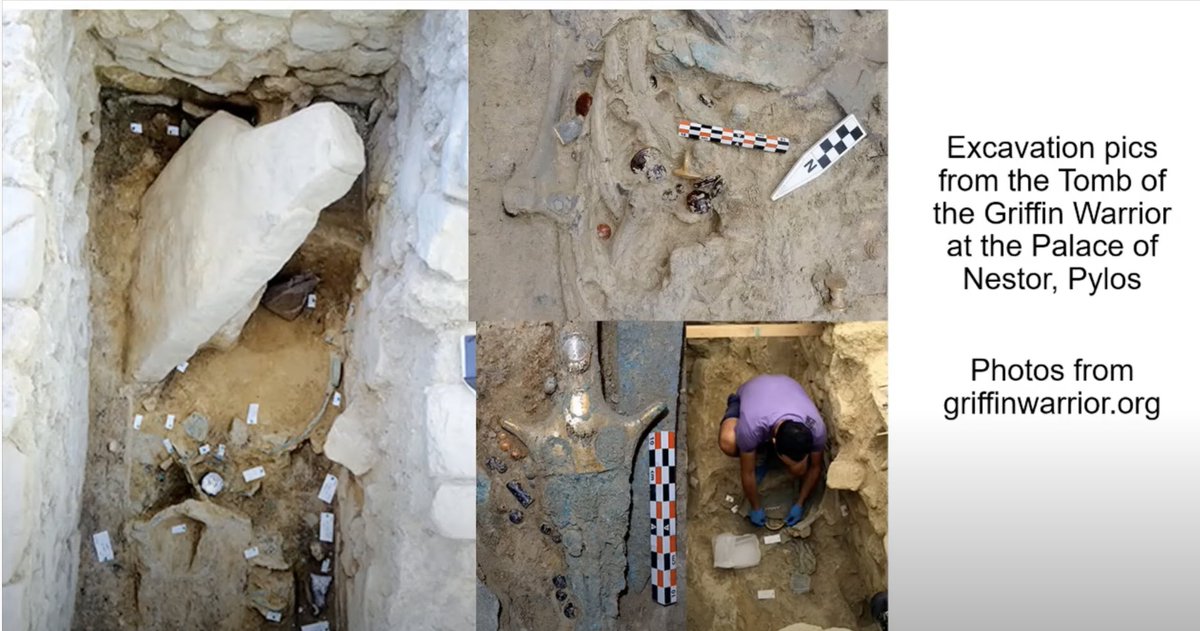For #CYO1 on #Prehistory #CLST6 I listened to a podcast about mummification practices in ancient Egypt and how they related to class hierarchies. In this podcast episode, bioarcheology is discussed through the lens of mummification practices across different social classes. 1/13
Andrew Arsenault, a graduate student from Western University, discussed how mummification practices changed across Egypt across the eras. In the Old Kingdom (~2600 BC), only the pharaohs and their families were mummified. 2/13
By the Middle Kingdom (~2000 BC), mummification was still an elite practice, but high-ranking priests were also mummified. Then by the New Kingdom (~1600), mummification was widespread and an option for everyone, but even then there were still disparities. 3/13
For example, wealthy people were buried with many belongings; Egyptians believed that they needed personal belongings in the afterlife in order to properly leave the mortal realm. The wealthier the individual, the nicer the items they could afford to be buried with. 4/13
Therefore, most “significant” archeological finds are those of the wealthy, for wealthy burials have higher quality artifacts found with them. This is similar to our findings in Mycenean Tombs, like the Tomb of the Griffin Warrior. 5/13
This find is so astonishing because of the sheer number of artifacts in it, probably due to the dead& #39;s wealth or significance. As Arsenault discusses, we know more about the lives of the wealthy, because the material evidence of life are seen as more interesting to study 6/13
Another factor that causes a class discrepancy in mummy studies (mummoligy?) is the embalming process. For the elites, this process took over 70 days, and had both scientific and spiritual traditions attached to it. 7/13
But middle and lower class Egyptians could not afford to pay for such an intensive, detailed process. Because of this, the bodies are not preserved as well. Additionally, burial sites of “normal” people were less favorable and more cramped. 8/13
Some evidence points to the idea that the Minoans inherited elaborate burial practices and post-death beliefs from the Egyptians, who would stop at Crete on their way to trade with mainland Greece, and that Crete might have been the source for honey used in mummification. 9/13
Just like the Egyptians, Minoan burial practices are a bit overboard. Many different burial practices were followed across the Neolithic and Bronze Ages. One of the most elaborate types was the Minoan “house tomb,” which was modeled after a house for the living at the time. 10/13
The belief behind this was that the dead needed a proper place to live after they died, similar to the multi-room tombs of the Egyptian royalty. This also contributes to the idea why both Egyptians and Minoans put everyday items in with burials; the dead would need them 11/13
Continuing with Arsenault’s original point, focusing on the more impressive aspects of archeology still only enlightens us on the lives of the wealthy, and doesn’t provide us with knowledge regarding any other social classes 12/13
What is the solution to this? We may have to change the way archeologists receive funding. Studying “normal” stuff isn’t as glamorous and is harder to display as appealing to investors, but it would give more insight about ancient people than yet another lavish burial 13/13
Sources:
Podcast: https://archandanth.com/episode-86-interview-with-andrew-arsenault/
Tweet">https://archandanth.com/episode-8... 5: Elite Mycenean Tombs, 4:47
Tweet 9: Death, Ritual and Belief: The Rhetoric of Funerary Rites, 32.
Tweet 10: A History of Greek Art, 43
Tweet 11: https://www.annenewman.com.au/magnificient-mansions-king-tutankhamons-tomb/">https://www.annenewman.com.au/magnifici...
Podcast: https://archandanth.com/episode-86-interview-with-andrew-arsenault/
Tweet">https://archandanth.com/episode-8... 5: Elite Mycenean Tombs, 4:47
Tweet 9: Death, Ritual and Belief: The Rhetoric of Funerary Rites, 32.
Tweet 10: A History of Greek Art, 43
Tweet 11: https://www.annenewman.com.au/magnificient-mansions-king-tutankhamons-tomb/">https://www.annenewman.com.au/magnifici...
More stuff!
This didn’t fit into the narrative of my thread but there is a theory that Knossos was actually a death shrine and that it was a city for the dead; and it IS known that the Minoans practiced human sacrifice.
This didn’t fit into the narrative of my thread but there is a theory that Knossos was actually a death shrine and that it was a city for the dead; and it IS known that the Minoans practiced human sacrifice.
But the necropolis theory (made by Hans Georg Wunderlich) is widely disproved (and I don’t believe it either) but was just super interesting to me and I wanted to share!
Sources on this stuff: #metadata_info_tab_contents">https://www.jstor.org/stable/634841?seq=1 #metadata_info_tab_contents
https://www.jstor.org/stable/63... href=" http://www.ssqq.com/travel/greece2008x06crete.htm">https://www.ssqq.com/travel/gr...
Sources on this stuff: #metadata_info_tab_contents">https://www.jstor.org/stable/634841?seq=1 #metadata_info_tab_contents

 Read on Twitter
Read on Twitter





